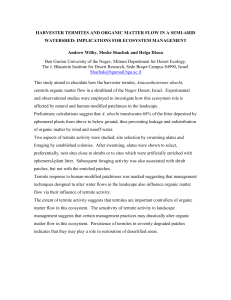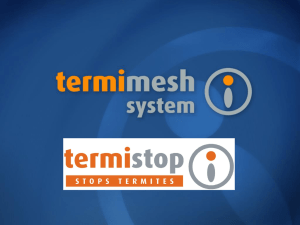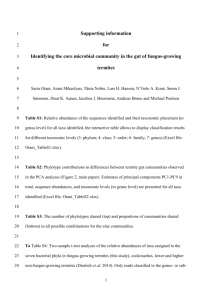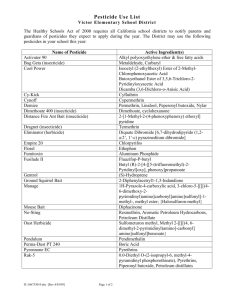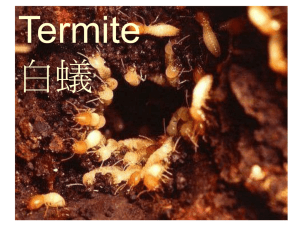12b- Termiticides
advertisement
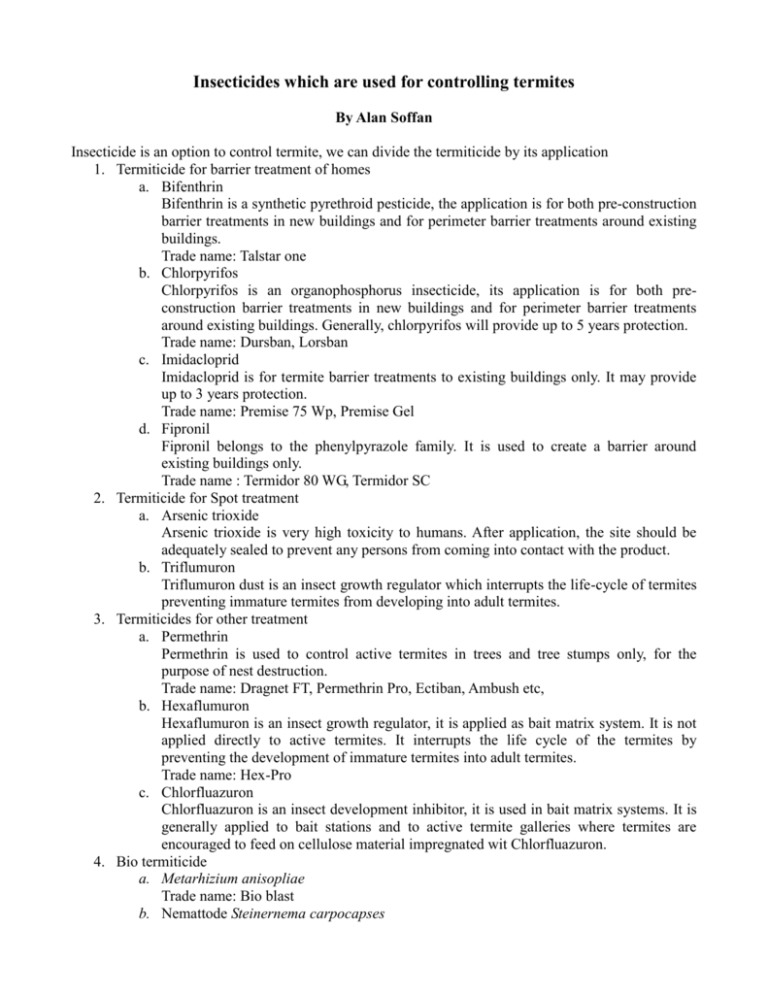
Insecticides which are used for controlling termites By Alan Soffan Insecticide is an option to control termite, we can divide the termiticide by its application 1. Termiticide for barrier treatment of homes a. Bifenthrin Bifenthrin is a synthetic pyrethroid pesticide, the application is for both pre-construction barrier treatments in new buildings and for perimeter barrier treatments around existing buildings. Trade name: Talstar one b. Chlorpyrifos Chlorpyrifos is an organophosphorus insecticide, its application is for both preconstruction barrier treatments in new buildings and for perimeter barrier treatments around existing buildings. Generally, chlorpyrifos will provide up to 5 years protection. Trade name: Dursban, Lorsban c. Imidacloprid Imidacloprid is for termite barrier treatments to existing buildings only. It may provide up to 3 years protection. Trade name: Premise 75 Wp, Premise Gel d. Fipronil Fipronil belongs to the phenylpyrazole family. It is used to create a barrier around existing buildings only. Trade name : Termidor 80 WG, Termidor SC 2. Termiticide for Spot treatment a. Arsenic trioxide Arsenic trioxide is very high toxicity to humans. After application, the site should be adequately sealed to prevent any persons from coming into contact with the product. b. Triflumuron Triflumuron dust is an insect growth regulator which interrupts the life-cycle of termites preventing immature termites from developing into adult termites. 3. Termiticides for other treatment a. Permethrin Permethrin is used to control active termites in trees and tree stumps only, for the purpose of nest destruction. Trade name: Dragnet FT, Permethrin Pro, Ectiban, Ambush etc, b. Hexaflumuron Hexaflumuron is an insect growth regulator, it is applied as bait matrix system. It is not applied directly to active termites. It interrupts the life cycle of the termites by preventing the development of immature termites into adult termites. Trade name: Hex-Pro c. Chlorfluazuron Chlorfluazuron is an insect development inhibitor, it is used in bait matrix systems. It is generally applied to bait stations and to active termite galleries where termites are encouraged to feed on cellulose material impregnated wit Chlorfluazuron. 4. Bio termiticide a. Metarhizium anisopliae Trade name: Bio blast b. Nemattode Steinernema carpocapses c. Bacterium Heterorbabitis bactgeriophora References Anonim.2006.Approved Pesticides for termite treatments.Department of Health, Western Australia. Anonim. 2007. Subterranean termite control products for Alabamians. Alabama A&M and Auburn Universities. Ware, George.1983. Pesticides, Theory and applications.W.H. Freeman and Company. San Frasisco.308p. By Arya Widyawan Insecticide is used to control population of insect pest under injury level, so that it will not cause a damage. The population of termite may be controlled by using a some insecticides. At least there are 6 class of insecticides that may be use to control termite(Table1) Table 1. Insecticide used to control termite Class Termiticide Organochlorine Cyclodiens Nicotinoids Imidacloprid (systemic insecticide) Spinosyn SpinosAD Fiproles Fipronil Fumigants Methyl Bromide Inorganic Sodium borate (Ware and Whitacre, 2004) Organochlorine One of insecticide that may be used to control termite from the Organochlorine class is cyclodiens. Cyclodiens is stable insecticide and relatively stable to ultraviolet. It is stay longer in soil. Beacause of that it is used greatest quantity as soil insecticide to control termite. Some example of cyclodiens is Chlordane, Heptachlor, Aldrin, and Dieldrin (Ware and Whitacre, 2004) Nicotinoids Nicotinoids is a new class of insecticide with a new mode of action. It is a systemic insecticide and used as soil treatment in vegetable, fruit and cereal farm. The mode of action of this insecticide is act on the central nervous system of insects, causing irreversible blockage of postsynaptic nicotinergic acetylcholine receptors (Ware and Whitacre, 2004) Spinosyn Spinosyn is a result of a fermentation metabolite of the actinomycete Saccharopolyspora spinosa, a soil-inhabiting microorganism. The has both contact and stomach activity against termites (Ware and Whitacre, 2004). Fiproles Fiproles is a systemic insecticide with contact and stomach activity. as means to control termites, fiproles is used as seed treatment and formulated as a baits (Ware and Whitacre, 2004). Effectiveness in insecticide application to control termite depend on the dosage of the pesticide. It s suggested to use a dosage exactly in order to achieve the success in control. Besides that using a exact dosage may reduce the effect of the insecticide to the environment. Such pesticide such as methyl bromide may harmful the environment. Below are some dosage of insecticide which is used to termite (Table 2). Table 2. Dosage of Insecticide Pesticide Dieldrin Aldrin Heptachlor Pentachlorophenol Dosage 0.5% 0.5% 0.5% 5% Objective Soil treatment 18 to 40 grams a.i / acre 5% in fuel oil at 2-4 litres /1 sq. meter 5% in fuel oil at 2-4 litres /1 sq. meter Or emulsion in water at 2-4 litres /1 sq. meter 2.5% in water at 6-10 liters/1 sq. meter 10% in water at 6-10 liters/1 sq. meter 0.8% in fuel oil or emulsion in water at 6-10 liters/1 sq. meter 1% in fuel soil at 6-10 liters/1 sq. meter 0.3% as emulsion in water at 5 litres/1 sq. meter Seed treatment Chemical barrier to protect a structure or foundation of building Methyl bromide 1 kilo/30m3 Bifenthrin (synthetic pyrethroid pesticide) 0.1%; 0.05% and 0.25% Protect the furniture from dry wood termites (Kalotermes; Kalotermitidae) by fumigation for 15 – 20 hours at temperature 21o C or over barrier treatments to existing buildings only SpinosAD Copper naphthenate Pentachlorophenol Sodium pentachlorophenate Sodium arsenite Benzene hexachloride Chlordane Dieldrin Imidacloprid 0.25% Arsenic trioxide (carcinogenic) 1 up to 2 grams for each spot (Source: Harris 1971, Environmental Health Directorate 2006 ) Spot treatment References Environmental Health Directorate, 2006. Approved pesticide for termite treatments environmental health guide. Perth. On line source at http://www.public.health.wa.gov.au/cproot/1791/2/Approved_Pesticides_for_Termite_Treatments.pdf Harris, W.V. 1971. Termites: their recognition and control. 2nd ed. Longman, London. Ware, G.W. and D.M. Withacre. 2004. An introduction to insecticide. 4th ed. MeisterPro Information Resources, Ohio By Boy Valenza Damiri Cyclodiene is persistent insecticide group which is stable in soil and is relatively stable to the ultraviolet action of sunlight. This pesticide group has been used in greatest quantity as soil insecticides, especially chlordane, heptaclor, aldrin, and dieldrin (Ware, 1978; Plapp, 1978; Bateman, 1979 ; Ware, 1983). Also, an approved insecticide such as Dursban (chlorpyrifos) or permethrin can also be used for controlling termites, either by spraying or injecting (Bateman, 1979). The other pesticide such as DDT (Dichloro-diphenyl-trichloroethane), Copper-chrome-arsenic, creosote, naphtenates, and sulfuryl fluoride were also widely used for controlling termite colonies in this world (Harris, 1971). Chlorinated solvent, which contain an ultra low concentration of chlorinated cyclodiene and dieldrin insecticide, is used as impregnating materials for covering and protecting the woody things from termite infestations (Ware, 1978). Pentachlorophenol is the chlorinated phenols which belong to phenol derivatives that is also used for termite protection and wood treatment for fungal rots (Ware, 1983). Methyl bromide and sulfuryl fluoride are fumigants for controlling termites above ground area or buildings (Harris, 1971 ; Ware, 1983). Sulfuryl fluoride is more expensive than methyl bromide, but it is more effective than methyl bromide and it only need low concentration to kill termites (Harris, 1971). References: Bateman, P. L. G. 1979. Household Pests. Blandford Press. Poole. □ Burgess, N. R. H. 1990. Public Health Pests. A Guide to Identification, Biology and Control. Chapman and Hall. London. □ Harris, W. V. 1971. Termites. Their Recognation and Control. Longman. □ Plapp, F. W. 1978. Insecticides in the Urban Environment. Academic Press. □ Ware, G. W. 1978. The Pesticide Book. W. H. Freeman and Company. San Fransisco.□ Ware, G. W. 1983. Pesticides. Theory and Application. W. H. Freeman and Company. San Fransisco. □ By Haris Setyaningrum Termites some time in house building as pest that very damaged especially to wood good. So need to control, while in the forest termites is usefully. Some the pesticide usually used for controlling termites, usually bait are used for it. this list of the pesticide for controlling termites: 5. Diflubenzuron (an insect growth regulator). 6. Hexaflumuron (an insect growth regulator) 7. Hydramethylnon ( a slow acting stomach toxicant) 8. Noviflumuron (chemically similar to hexaflumuron) 9. Aldrin 10. Dieldrin 11. Chlordane 12. Hepatachlor 13. Boric acid 14. Borates 15. Bifenthrin 16. Chlorphyrifos 17. Imidacloprid 18. Fipronil 19. Arsenic trioxide 20. Permethrin (Caroline, 2004; Anderson, 2002; Harte, 1991; Anon, 2006) References : Cox, Caroline. 2004. Boric acid and Borates.Journal of pesticide reform. Summer 2004. Vol. 24 no. 2. Anderson, L.O. 2002. Wood - Frame House Construction. The Minerva group inc. publ. Harte, John. 1991. Toxics A to Z: A Guide to Everyday Pollution Hazards. University of California Press. California. Anon, 2006. Approved pesticide for treatments termites environmental health guide. Environmental health directorate, department of health, Western Australia.
